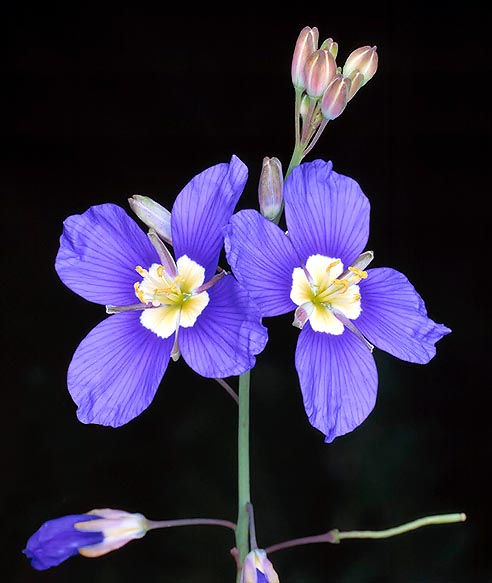Family : Brassicaceae

Text © Pietro Puccio

English translation by Mario Beltramini

The Heliophila corocopifolia is maybe the nicest extant brassica © Giuseppe Mazza
The name of the genus is the combination of the Greek words “élios”= sun, and “philos” = friend, with obvious signification; the name of the species is the combination of the name “coronopus” and the Latin word “folia” = leaf, due to the resemblance of the leaves with those of the Plantago coronopus.
Common names: African blue flax, blue eyes, fairy-of-the-veldt, showy sunflax, sporries, wild flax (English); héliophile corne de cerf (French); lino azul (Spanish); Sonnenschein, Langblättriger, Langblättriger Sonnenschein (German).
The Heliophila coronopifolia L. (1763) is an annual herbaceous plant, up to about 60 cm tall with erect stems, at times tomentose at the base, and 5 cm long, bright green leaves, being the inferior ones pinnatipartite, with 0,6-1 cm long and 2 mm broad, filiform lobes, and the upper ones entire and getting shorter progressively. The inflorescences, in terminal racemes, carry 8 to 16 small flowers with four purplish sepals and 4-lobed corolla of an intense blue colour with white or greenish centre.
The flowers close by night or with overcast and cool weather. The fruits are 3-9 cm long siliquae, thin, containing several round and flat, tiny seeds. It reproduces by seed which may be put in place directly in late winter-early spring which usually germinates in 1-2 weeks.
Plant of fast growth and of easy cultivation, requires an exposition in full sun and well drained soils; watering must be regular during the growing period, even if it may stand, if well rooted, drought periods. Plant with delicate appearance and particularly intense color, it is ideal when utilized in mass for realizing flowerbeds or mixed edges, thanks also to its long blossoming period, from spring to late summer. When in pot, it is advisable to add sand or agri-perlite to the mould for improving the drainage.
Synonyms: Heliophila filifolia L. f. (1781); Heliophila filiformis L. f. (1781); Heliophila heterophylla Thunb. (1800); Heliophila longifolia DC. (1821); Heliophila dissecta var. pinnata DC. (1821); Heliophila sonchifolia DC. (1821); Carponema filiforme Eckl. & Zeyh. (1834); Leptormus caledonicus Eckl. & Zeyh. (1834); Heliophila caledonica Sond. (1840); Heliophila fistulosa Sond. (1846); Heliophila sphaerostigma Kuntze (1846).
→ For general notions about BRASSICACEAE please click here.
→ To appreciate the biodiversity within the BRASSICACEAE family please click here.
